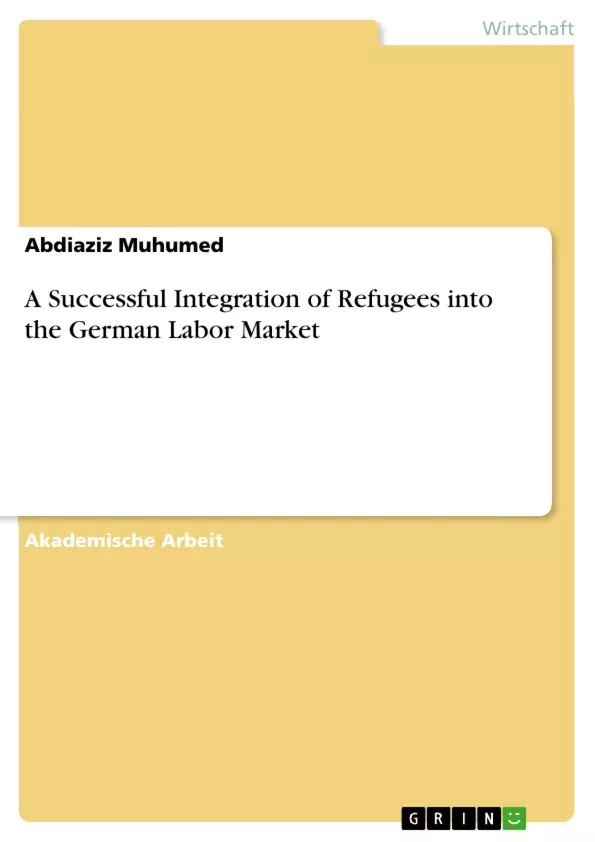Migration has become an important socioeconomic phenomenon in many countries around the world including Germany. There has been a large number of refugees coming into Europe specifically in Germany in the past couple of years. This has resulted an increased interest in promoting stable solution. Integration of refugees has become a central issue in the process of seeking solution for the sudden influx of unexpected number of refugees.
This article considers the integration of refugees into the labor market in Germany. It focuses on how the refugees can successfully be integrated into the labor market and discusses about the barriers as well as the supporting measures to an effective labor market Integration of refugees and asylum seekers. Integration of refugees into the German society especially into the German labor market became polarized in the public discussions.There have been several law enactments to improve the labor integration of the refugees in the past couple of years which has seen a policy shift facilitating labor market access for refugees and asylum seekers. This has allowed the refugees and asylum seekers to get a quick access to the labor market. According to several sources this has increased the proportion of working refugees and asylum seekers.
Inhaltsverzeichnis
- Abstract
- 1. Introduction
- 2. Migration in Germany: Numbers, Data and Facts
- 2.1 Clarification of Terms and Legal Frameworks
- 2.2 Migration to Germany over the Past Decade
- 3. Integration of Refugees and Asylum-seekers: Overview
- 3.1 Labor Market Situation in Germany
- 3.2 Legal Framework for Refugee Integration
- 3.3 Barriers to Entry to the Labor Market for the Refugees and Asylum-seekers
- 3.4 Legislative Changes and Policy Measures for Supporting Refugees' Integration into the Labor Market
- 4. Conclusion
- References
Zielsetzung und Themenschwerpunkte
Diese Arbeit untersucht die Integration von Flüchtlingen in den deutschen Arbeitsmarkt. Das Hauptziel ist es, die Herausforderungen und erfolgreichen politischen Maßnahmen zur Unterstützung einer erfolgreichen Integration von Flüchtlingen und Asylbewerbern zusammenzufassen. Die Arbeit analysiert die rechtlichen und politischen Rahmenbedingungen, die den Zugang von Flüchtlingen zu Beschäftigungsmöglichkeiten erleichtern.
- Migration nach Deutschland und statistische Daten
- Definitionen und rechtliche Rahmenbedingungen von Migration, Migranten und Flüchtlingen
- Herausforderungen bei der Arbeitsmarktintegration von Flüchtlingen
- Politische Maßnahmen zur Förderung der Arbeitsmarktintegration
- Bewertung der Erfolgsfaktoren der Integrationspolitik
Zusammenfassung der Kapitel
1. Introduction: Dieses Kapitel führt in das Thema der Flüchtlingsintegration in den deutschen Arbeitsmarkt ein. Es beschreibt den weltweiten Kontext von Migration und Flucht, den starken Anstieg der Flüchtlingszahlen in Deutschland in den letzten Jahren und die daraus resultierende Bedeutung der Integrationspolitik. Es hebt die frühere restriktive Arbeitsmarktpolitik gegenüber Flüchtlingen hervor und beschreibt den Wandel hin zu einer Politik, die den Arbeitsmarktzugang erleichtert. Der Fokus liegt auf der zentralen Forschungsfrage: Wie kann eine erfolgreiche Integration von Flüchtlingen in den deutschen Arbeitsmarkt erreicht werden?
2. Migration in Germany: Numbers, Data and Facts: Dieses Kapitel liefert einen Überblick über die Migration nach Deutschland, unterteilt in die Klärung von Begriffen (Migration, Migrant, Flüchtling) und deren rechtlichen Grundlagen sowie die Darstellung der Migrationszahlen der letzten Dekade. Es bietet Definitionen von Migration, Migrant und Flüchtling auf Basis internationaler Organisationen und betont den Unterschied zwischen freiwilliger Migration und Flucht. Die Darstellung der Migrationszahlen dient als Grundlage für die spätere Analyse der Integrationsmaßnahmen.
3. Integration of Refugees and Asylum-seekers: Overview: Dieses Kapitel analysiert die Arbeitsmarktintegration von Flüchtlingen in Deutschland. Es beleuchtet die Situation auf dem deutschen Arbeitsmarkt, den rechtlichen Rahmen für die Integration von Flüchtlingen, sowie die Hindernisse, denen Flüchtlinge und Asylbewerber beim Arbeitsmarktzugang begegnen. Ein Schwerpunkt liegt auf den gesetzlichen Änderungen und politischen Maßnahmen zur Unterstützung der Integration. Es werden sowohl Herausforderungen als auch unterstützende Maßnahmen detailliert betrachtet. Die Zusammenfassung der einzelnen Unterkapitel synthetisiert die verschiedenen Aspekte der Integrationspolitik und ihrer Auswirkungen auf den Arbeitsmarktzugang von Flüchtlingen.
Schlüsselwörter
Migration, Flüchtlinge, Asylbewerber, Integration, Arbeitsmarkt, Integrationspolitik, Deutschland, rechtliche Rahmenbedingungen, Beschäftigung, Herausforderungen, Maßnahmen, Erfolgsfaktoren.
Häufig gestellte Fragen (FAQ) zur Arbeit: Integration von Flüchtlingen in den deutschen Arbeitsmarkt
Was ist der Gegenstand dieser Arbeit?
Diese Arbeit untersucht die Integration von Flüchtlingen in den deutschen Arbeitsmarkt. Sie analysiert die Herausforderungen und erfolgreichen politischen Maßnahmen zur Unterstützung einer erfolgreichen Integration von Flüchtlingen und Asylbewerbern, unter Berücksichtigung der rechtlichen und politischen Rahmenbedingungen.
Welche Themen werden behandelt?
Die Arbeit behandelt folgende Themen: Migration nach Deutschland und statistische Daten; Definitionen und rechtliche Rahmenbedingungen von Migration, Migranten und Flüchtlingen; Herausforderungen bei der Arbeitsmarktintegration von Flüchtlingen; politische Maßnahmen zur Förderung der Arbeitsmarktintegration; und die Bewertung der Erfolgsfaktoren der Integrationspolitik.
Welche Kapitel umfasst die Arbeit?
Die Arbeit gliedert sich in folgende Kapitel: Einleitung, Migration in Deutschland: Zahlen, Daten und Fakten (inkl. Klärung von Begriffen und rechtlichen Rahmenbedingungen sowie Migrationszahlen der letzten Dekade), Integration von Flüchtlingen und Asylbewerbern: Überblick (inkl. Arbeitsmarktsituation, rechtlicher Rahmen, Barrieren und politische Maßnahmen), und Schlussfolgerung. Zusätzlich enthält die Arbeit ein Abstract, ein Inhaltsverzeichnis, eine Zusammenfassung der Kapitel und ein Glossar mit Schlüsselwörtern.
Was ist das Hauptziel der Arbeit?
Das Hauptziel ist es, die Herausforderungen und erfolgreichen politischen Maßnahmen zur Unterstützung einer erfolgreichen Integration von Flüchtlingen und Asylbewerbern in den deutschen Arbeitsmarkt zusammenzufassen und zu analysieren, wie der Zugang von Flüchtlingen zu Beschäftigungsmöglichkeiten erleichtert werden kann.
Welche Methoden werden angewendet?
Die Arbeit stützt sich auf die Analyse von Zahlen, Daten, Fakten und der bestehenden Literatur zur Flüchtlingsintegration in Deutschland. Sie beschreibt den rechtlichen Rahmen und analysiert die Herausforderungen und Maßnahmen zur Integration.
Welche Schlüsselwörter sind relevant?
Die relevanten Schlüsselwörter sind: Migration, Flüchtlinge, Asylbewerber, Integration, Arbeitsmarkt, Integrationspolitik, Deutschland, rechtliche Rahmenbedingungen, Beschäftigung, Herausforderungen, Maßnahmen, Erfolgsfaktoren.
Wie ist die Arbeit strukturiert?
Die Arbeit ist übersichtlich strukturiert mit einem Inhaltsverzeichnis, einer klaren Kapitelzusammenfassung und einer Zusammenfassung der wichtigsten Ergebnisse. Die Sprache ist prägnant und die Informationen werden strukturiert und professionell präsentiert.
Für wen ist diese Arbeit bestimmt?
Diese Arbeit ist für Wissenschaftler, Studenten, politische Entscheidungsträger und alle anderen, die sich für die Thematik der Flüchtlingsintegration in den deutschen Arbeitsmarkt interessieren, bestimmt.
Wo finde ich weitere Informationen?
Weitere Informationen finden Sie im Literaturverzeichnis der Arbeit.
- Quote paper
- Abdiaziz Muhumed (Author), 2021, A Successful Integration of Refugees into the German Labor Market, Munich, GRIN Verlag, https://www.grin.com/document/1183723



